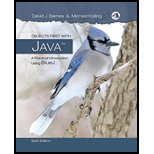
Explanation of Solution
Given: The class named ArrayList is discovered inside the java.util package, which includes another class known as Linked List.
To find:
The information about LinkedList.
The comparison between ArrayList and LinkedList.
The methods that are similar and different between LinkedList and Arraylist.
Solution:
The implementation of LinkedList is slightly different from that of ArrayList in Java. These are:
LinkedList preserves its elements in the form of doubly-linked list whereas in case of ArrayList, it's a simple dynamic array which expands or shrinks according to the number of elements added to it.
We can also insert elements at any place in a LinkedList since it retains the track of linking between previous and next elements, whereas in case of ArrayList we can also insert elements at any position in the list but it requires shifting of all the latter elements to create space for new elements.
When huge number of elements are added to an ArrayList which if crosses its underlying size of the array, then a new array double of its size is reserved and the old array gets copied into the new one. But in case if LinkedList no such thing happens, since its underlying structure is not an array, a list of elements each of which is linked together by its previous and next memory locations.
The methods which are common to both the ArrayList and LinkedList, are given below with their workings:
add(int index, Object element) – used to add an element at particular index of the list.
add(Object element) - appends an element at the termination of the list.
addAll(Collection c) - adds a collection at the termination of the list.
addAll(int index, Collection c) - inserts a collection at a specified index of the list.
clear() - removes all the elements of the list.
clone() - copies an instance of the list to a new array and then returns that array.
contains(Object element) - checks to see that the specified element exists in the list or not. If so, it returns true else returns false.
get(int index) – used to return the element of the stated index of the list.
indexOf(Object element) – used to return an index for the first occurrence of the specific element that is stated in the list if it is found, or else it returns -1...
Want to see the full answer?
Check out a sample textbook solution
Chapter 4 Solutions
Objects First with Java: A Practical Introduction Using BlueJ (6th Edition)
- Could you help me to know features of the following concepts: - defragmenting. - dynamic disk. - hardware RAIDarrow_forwardwhat is a feature in the Windows Server Security Compliance Toolkit, thank you.arrow_forwardYou will write a program that allows the user to keep track of college locations and details about each location. To begin you will create a College python class that keeps track of the csollege's unique id number, name, address, phone number, maximum students, and average tuition cost. Once you have built the College class, you will write a program that stores College objects in a dictionary while using the College's unique id number as the key. The program should display a menu in this order that lets the user: 1) Add a new College 2) Look up a College 4) Delete an existing College 5) Change an existing College's name, address, phone number, maximum guests, and average tuition cost. 6) Exit the programarrow_forward
- Show all the workarrow_forwardShow all the workarrow_forward[5 marks] Give a recursive definition for the language anb2n where n = 1, 2, 3, ... over the alphabet Ó={a, b}. 2) [12 marks] Consider the following languages over the alphabet ={a ,b}, (i) The language of all words that begin and end an a (ii) The language where every a in a word is immediately followed by at least one b. (a) Express each as a Regular Expression (b) Draw an FA for each language (c) For Language (i), draw a TG using at most 3 states (d) For Language (ii), construct a CFG.arrow_forward
- Question 1 Generate a random sample of standard lognormal data (rlnorm()) for sample size n = 100. Construct histogram estimates of density for this sample using Sturges’ Rule, Scott’s Normal Reference Rule, and the FD Rule. Question 2 Construct a frequency polygon density estimate for the sample in Question 1, using bin width determined by Sturges’ Rule.arrow_forwardGenerate a random sample of standard lognormal data (rlnorm()) for sample size n = 100. Construct histogram estimates of density for this sample using Sturges’ Rule, Scott’s Normal Reference Rule, and the FD Rule.arrow_forwardCan I get help with this case please, thank youarrow_forward
 EBK JAVA PROGRAMMINGComputer ScienceISBN:9781337671385Author:FARRELLPublisher:CENGAGE LEARNING - CONSIGNMENT
EBK JAVA PROGRAMMINGComputer ScienceISBN:9781337671385Author:FARRELLPublisher:CENGAGE LEARNING - CONSIGNMENT C++ Programming: From Problem Analysis to Program...Computer ScienceISBN:9781337102087Author:D. S. MalikPublisher:Cengage LearningNp Ms Office 365/Excel 2016 I NtermedComputer ScienceISBN:9781337508841Author:CareyPublisher:Cengage
C++ Programming: From Problem Analysis to Program...Computer ScienceISBN:9781337102087Author:D. S. MalikPublisher:Cengage LearningNp Ms Office 365/Excel 2016 I NtermedComputer ScienceISBN:9781337508841Author:CareyPublisher:Cengage- COMPREHENSIVE MICROSOFT OFFICE 365 EXCEComputer ScienceISBN:9780357392676Author:FREUND, StevenPublisher:CENGAGE L
 Microsoft Visual C#Computer ScienceISBN:9781337102100Author:Joyce, Farrell.Publisher:Cengage Learning,
Microsoft Visual C#Computer ScienceISBN:9781337102100Author:Joyce, Farrell.Publisher:Cengage Learning,





